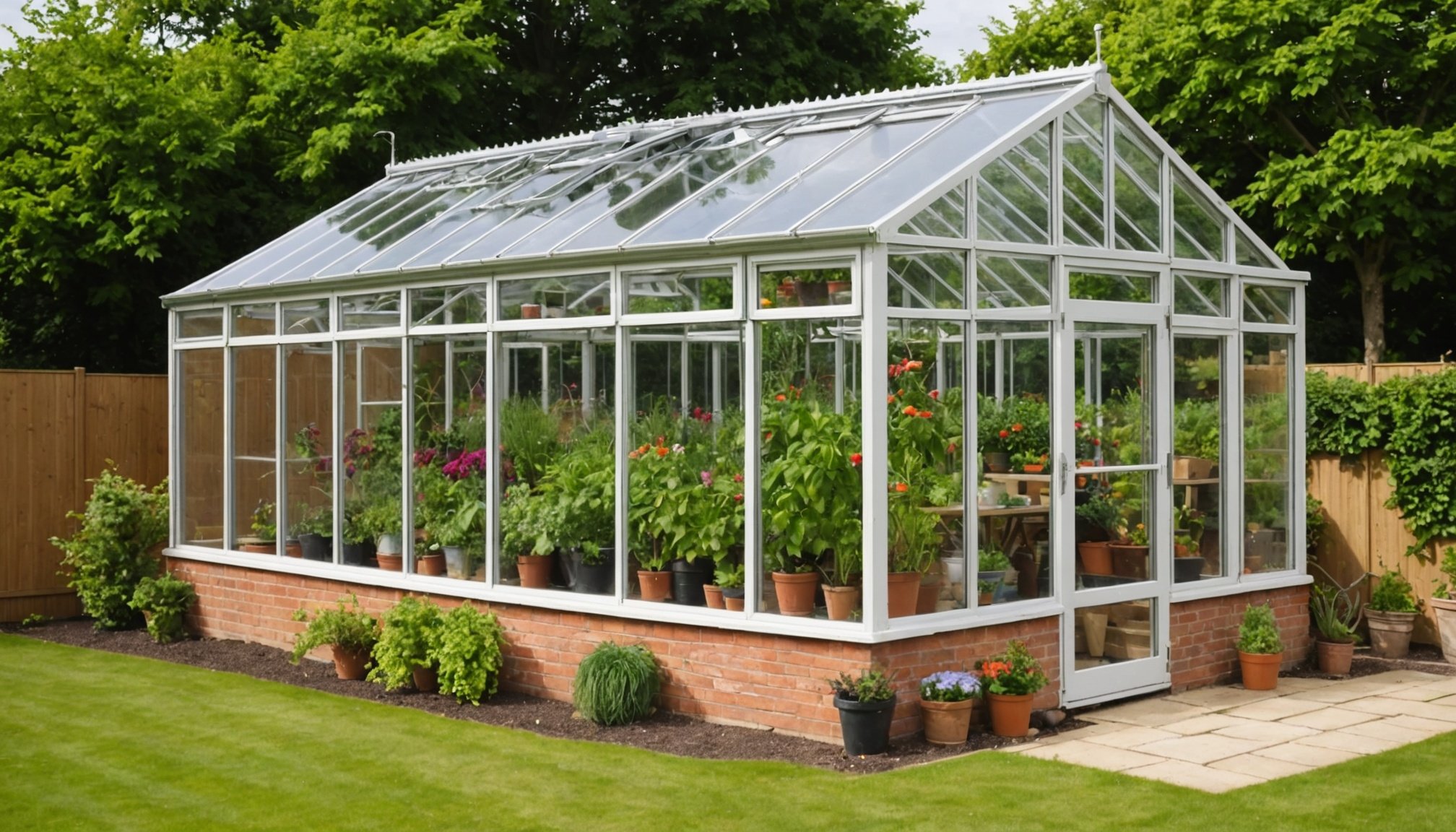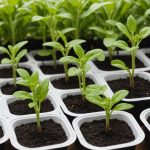Overview of Energy-Efficient Greenhouse Design
Constructing an energy-efficient greenhouse not only enhances the vitality of your garden but considerably contributes to a sustainable environment. Emphasising energy efficiency within greenhouse design assures lower energy consumption, effectively reducing the carbon footprint—a critical step for eco-conscious UK homeowners.
With a growing interest in sustainable gardening, UK homeowners are driving a trend towards more resourceful practices. Adopting an energy-efficient greenhouse aligns with this trend by providing a controlled climate that optimises plant growth while conserving resources. This type of design typically incorporates advanced insulation materials, automated ventilation systems, and efficient heating solutions.
Also to read : Ultimate Guide: Calculating the Perfect Rain Barrel Size for Your Suburban Garden in the UK
Benefits for UK Homeowners
- Cost Savings: Reduced energy bills through efficient heating and cooling mechanisms translate into direct savings.
- Environmental Contribution: Using less energy means lower greenhouse gas emissions, playing an active role in environmental conservation.
- Increased Productivity: Optimal conditions in energy-efficient greenhouses often lead to healthier plants and higher yields.
Embracing sustainable gardening practices within your energy-efficient greenhouse can further enhance these benefits. Examples include recycling rainwater for irrigation, using organic soil mixes, and incorporating native plant species that require less maintenance. By choosing these eco-friendly methods, you contribute to a sustainable future while enjoying the productivity gains from your garden.
Key Design Principles for Greenhouses
Understanding the greenhouse design principles for creating a thriving environment is crucial, especially in the specific conditions of the UK climate.
Also read : Fastest Smoke Alarm Technology for Multi-Floor Homes in the UK: What You Need to Know
Orientation and Layout
A well-thought-out orientation and layout are essential for optimal greenhouse performance. Positioning the greenhouse to maximize sunlight exposure is crucial. In areas like the UK, with variable sunlight, aligning the structure east-west is effective. This orientation ensures prolonged exposure to sunlight throughout the day, supporting plant growth.
Structural Materials
Choosing the right materials enhances both sustainable architecture and greenhouse durability. For UK weather, using materials that offer excellent insulation and resilience is vital. Polycarbonate panels and tempered glass are popular choices, providing sturdiness and good thermal insulation. These materials help maintain consistent internal temperatures, crucial for plant health.
Environmental Control Systems
Efficient environmental control systems play a vital role in greenhouse functionality. Implementing technologies such as automated ventilation systems, humidity sensors, and heating mechanisms can regulate temperature and humidity effectively. These innovations are indispensable in the UK climate, where external conditions fluctuate. Maintaining a balanced internal environment aids in reducing energy consumption and mitigates the potential for plant stress.
Climate Considerations in the UK
The UK climate is notably diverse, with variations that affect greenhouse gardening significantly. The nation is divided into different gardening zones, each characterised by specific temperature ranges and seasonal changes. Understanding these zones is crucial for successful greenhouse management.
In the UK, adapting greenhouse designs to the unique climate zones is essential. These zones range from mild in the South to cooler and wetter conditions in the North and West. Such diversity means that greenhouses must be designed with flexibility to withstand seasonal fluctuations effectively. For instance, additional insulation might be necessary in colder zones, whereas ventilation is more critical in warmer, southern regions.
Seasonal changes such as fluctuating temperatures, variable precipitation, and unexpected frosts can impact greenhouse performance. Gardeners must consider these factors when planning their greenhouse strategies. Localized weather patterns, like sudden storms or prolonged droughts, require robust structures and efficient water management systems. Utilizing rainwater harvesting and ensuring sturdiness in the face of high winds are examples of proactive adaptations.
By tailoring greenhouse designs to local climatic conditions, gardeners can optimize plant growth, ensuring productivity throughout the year, regardless of the UK’s notorious weather unpredictability.
Temperature and Light Management Strategies
In the ever-evolving world of sustainable gardening, effective temperature control and light management are essential. By understanding and implementing the right strategies, gardeners can maintain an optimal environment for their plants.
Passive Solar Techniques
Passive solar methods are ingenious for natural temperature control. They rely on smart design choices like specific window orientations and the use of thermal mass. Thermal mass, such as stone or water, can absorb heat during the day and release it at night. Proper ventilation further supports these techniques, allowing hot air to escape, thus maintaining moderate indoor conditions.
Active Heating and Cooling Systems
For regions such as the UK where seasons often bring unpredictable weather, active heating and cooling systems can be invaluable. These systems include heat pumps and automated fans, providing precise temperature control. They ensure that temperature-sensitive plants remain protected throughout the year. Additionally, these systems can be energy-efficient, aligning with environmental goals.
Supplemental Lighting Options
When natural light isn’t enough, grow lights step in. Particularly, LED grow lights offer a sustainable option, providing targeted light spectrum essential for plant growth. The benefits are significant: they reduce energy consumption, run cooler, and last longer compared to traditional lighting. Investing in quality grow lights ensures vibrant plants and year-round gardening success.
Sustainable Gardening Practices
Incorporating organic gardening methods within greenhouse design is essential for promoting sustainability. These practices include using natural fertilizers and pest control, which minimize chemical use and foster a healthy growing environment. By choosing organic materials, gardeners contribute positively to their ecosystem while maintaining robust plant health.
The benefits of integrating permaculture principles into a greenhouse setting are far-reaching. Permaculture focuses on creating self-sustaining ecosystems, meaning plants, animals, and microbes work symbiotically to enhance growth. This approach not only reduces external inputs but also enhances biodiversity and resilience in your greenhouse. It means less reliance on artificial resources and a more harmonious growing method.
Water conservation and soil health are critical components of sustainable gardening. Implementing strategies like rainwater harvesting and efficient irrigation systems helps conserve water resources. Mulching and composting improve soil structure and fertility, promoting healthy plant growth. Maintaining enriched soil ensures that plants receive the necessary nutrients over time, reducing the need for synthetic fertilizers.
By embracing these sustainable gardening practices, gardeners can create an environmentally friendly growing process. These methods ensure a productive and sustainable greenhouse that remains in balance with nature. Adopting these techniques helps protect our planet while cultivating a thriving green space.
Cost-Effective Solutions for Greenhouse Design
Creating a greenhouse doesn’t have to break the bank. With some DIY strategies and budget-friendly options, you can design a cost-effective structure perfect for cultivating your plants.
Sourcing Affordable Materials
Finding cost-saving materials is essential. Consider local stores for recycled or second-hand materials. Lumber yards sometimes have discounted wood that has minor imperfections. Additionally, explore online marketplaces and community groups where people often give away bricks, windows, or doors. Repurposing materials not only cuts costs but also contributes to sustainability.
DIY Design and Construction
A DIY greenhouse offers flexibility and significant savings. Start with a simple frame, using affordable materials like PVC pipes or metal rods. Clear plastic sheeting serves as an economical covering, providing good insulation while keeping costs low. Online tutorials and instructional videos are excellent resources to guide the construction process step-by-step. This approach not only saves money but can be a rewarding and educational experience.
Long-term Financial Benefits
Investing in energy-efficient features, such as solar-powered fans or drip irrigation systems, can lead to substantial long-term savings. These technologies, although slightly more costly upfront, reduce energy and water usage, decreasing utility bills. Over time, not only do they help the environment, but they also lower operating costs, making your greenhouse a cost-saving asset.
Case Studies and Successful Examples
Exploring successful projects in the realm of greenhouse case studies can provide invaluable insights for enthusiasts and professionals alike. Within the UK, there are numerous inspiring examples demonstrating how thoughtful planning and innovation lead to triumph in greenhouse gardening.
One notable UK example is the Eden Project in Cornwall, which showcases the potential of environmentally conscious greenhouse design. It features multiple biomes that replicate diverse climates and exemplify effective management of resources. Key design elements contributing to the success of this project include recyclable materials, an advanced solar control system, and the incorporation of sustainable water management techniques.
Another inspiring case is the Kew Gardens’ Temperate House, the world’s largest Victorian glasshouse in London. Its recent renovation focused on integrating modern technology with traditional design, ensuring energy efficiency while preserving historical value. Automated climate control and energy-efficient glass are among the innovative features ensuring its operational success.
From these projects, vital lessons can be learned about blending sustainability with practicality. Factors such as choosing the right materials, employing energy-efficient technology, and maintaining a balance between automation and manual intervention are pivotal. These practical experiences emphasize that attention to design and resource management can lead to sustainable and successful greenhouse gardening in the UK.
Resources and Tools for Greenhouse Planning
Ensuring a successful greenhouse planning process involves leveraging various design resources and gardening tools. Between the right software, educational materials, and community support, you’ll be well-equipped for a flourishing greenhouse.
Design Software and Planning Tools
To kickstart your greenhouse project, explore design software that specialises in creating precise plans tailored to your needs. Programs like SketchUp or Garden Planner offer intuitive platforms to draft layouts, factor in solar patterns, and optimise space efficiently. Such tools provide visual simulations, ensuring your design is both functional and aesthetically pleasing.
Educational Resources and Workshops
Gaining in-depth knowledge about greenhouse planning becomes easier with access to online courses and workshops. Websites like Coursera and Udemy host comprehensive courses on sustainable gardening and greenhouse management. These resources equip enthusiasts with vital skills, covering everything from plant selection to climate control inside greenhouses.
Community Support and Networks
Engaging with local gardening communities often proves invaluable. By participating in community groups or joining forums, one can share experiences, seek advice, and collaborate on projects. Local gardening clubs or online platforms like Reddit’s gardening community can be instrumental in exposing you to diverse perspectives and practical gardening tools, enriching your greenhouse planning journey.











